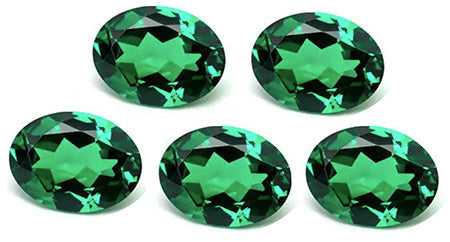Emerald 8x6 mm Oval Shape 8.66 carat 5 pcs
Emerald 8x6 mm Oval Shape 8.66 carat 5 pcs
Emeralds are highly prized gemstones known for their rich green color. Historically associated with royalty and romance, emeralds have been treasured for centuries.
Emerald 8x6 mm Oval Shape 8.66 carat 5 pcs ( Synthetic)
- Appearance: The oval cut is a popular choice for emeralds, combining the brilliance of a round cut with the elongated elegance of an oval shape. This cut enhances the stone's color and brilliance while providing a large surface area, which can make the gemstone appear larger.
- Cut: The oval cut typically features 57 to 58 facets, designed to maximize the gemstone’s sparkle and minimize the visibility of inclusions, which are common in emeralds.
Synthetic Emeralds
Synthetic emeralds, also known as lab-created or lab-grown emeralds, are produced in laboratories under controlled conditions that mimic the natural processes that form emeralds in the earth. These stones have the same physical, chemical, and optical properties as natural emeralds.
Characteristics of Synthetic Emeralds:
-
Color:
- Synthetic emeralds exhibit the same range of green hues as natural emeralds, from light to deep green. The color in synthetic emeralds can often be more evenly distributed, without the zoning (color variations) that can occur in natural stones.
-
Clarity:
- Lab-created emeralds typically have fewer inclusions compared to natural emeralds. These inclusions, often referred to as "jardin" (French for garden), are common in natural emeralds but less prevalent in their synthetic counterparts, leading to higher clarity.
-
Hardness:
- Emeralds, whether natural or synthetic, have a hardness of 7.5 to 8 on the Mohs scale. While relatively hard, emeralds are more brittle than other gemstones due to their inclusions and should be handled with care.
-
Refractive Index:
- Synthetic emeralds have a refractive index similar to that of natural emeralds, contributing to their brilliance and sparkle.
Origin and Production
Natural emeralds are primarily found in Colombia, Brazil, and Zambia. Synthetic emeralds, on the other hand, are produced in laboratories around the world, including the United States, Russia, and Germany. There are several methods for creating synthetic emeralds, including the hydrothermal method and the flux-growth method.
Uses and Popularity
Emeralds, both natural and synthetic, are highly valued in the jewelry industry. The oval cut is especially popular for rings, pendants, and earrings, providing a timeless and elegant look that highlights the stone's vivid green color.
Couldn't load pickup availability



